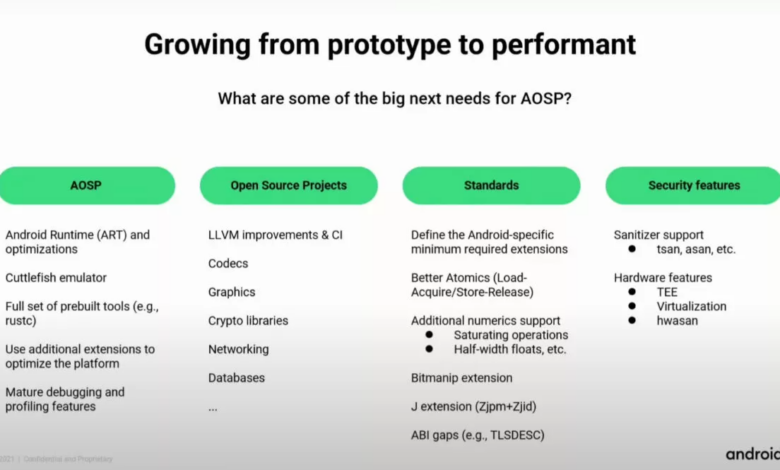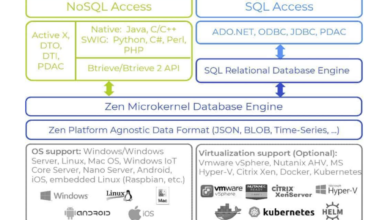
Emerging Platforms RISC and ARM Architectures
Emerging platforms risc and arm – Emerging Platforms: RISC and ARM architectures are revolutionizing the tech landscape. From smartphones to supercomputers, these energy-efficient processors are powering a new generation of devices. This post dives deep into the world of RISC and ARM, exploring their history, advantages, and the exciting future they promise.
We’ll unpack the fundamental differences between RISC and CISC, trace ARM’s incredible journey from humble beginnings to its current dominance, and analyze the performance and power efficiency that have made it a leader. We’ll also look at some cutting-edge applications, including the rise of AI and IoT, and consider the security implications of this widespread adoption. Get ready for a fascinating exploration!
Introduction to RISC and ARM Architectures
The world of computing relies heavily on processor architectures, and two dominant players in this arena are RISC (Reduced Instruction Set Computing) and ARM (Advanced RISC Machine). Understanding their fundamental differences and the evolution of ARM is crucial to grasping the landscape of modern computing devices. This discussion will explore these architectures, highlighting their key features and performance characteristics.
RISC versus CISC Architectures
The core distinction between RISC and CISC lies in their instruction sets. CISC (Complex Instruction Set Computing) architectures, like x86, utilize complex instructions that perform multiple operations in a single instruction cycle. This often leads to more compact code but requires more complex and slower hardware to decode and execute these instructions. In contrast, RISC architectures employ simpler instructions, each performing a single, well-defined operation.
This simplicity allows for faster execution speeds and more efficient hardware design, although it generally results in longer code sequences. The trade-off is that RISC’s faster clock speeds and simpler hardware design often outweigh the increase in code size.
Historical Development of ARM Architecture
ARM’s history begins in the 1980s at Acorn Computers. Designed initially for embedded systems, the ARM architecture prioritized low power consumption and efficiency, making it ideal for mobile devices. Its early designs were relatively simple, but subsequent iterations incorporated features like pipelining and superscalar execution to enhance performance. The licensing model adopted by ARM Holdings (now part of Nvidia) proved instrumental in its widespread adoption.
This model allowed numerous companies to design and manufacture ARM-based processors, fostering a vast ecosystem of devices ranging from smartphones and tablets to servers and IoT devices. The continuous evolution of ARM architecture, marked by advancements like 64-bit support and improvements in vector processing capabilities, has solidified its position as a leading processor architecture.
Comparative Analysis of RISC and ARM Processor Performance
While both are RISC architectures, it’s important to distinguish between the general RISC principles and the specific implementation of ARM. ARM processors, due to their focus on power efficiency and design flexibility, often exhibit excellent performance per watt, making them ideal for battery-powered devices. However, in terms of raw processing power for demanding tasks like high-end gaming or server workloads, some RISC architectures based on x86-64 (although CISC in origin, now largely RISC-like in implementation) might outperform certain ARM processors.
This performance gap is narrowing, though, with the emergence of high-performance ARM cores designed for data centers and cloud computing. The choice between RISC and ARM often hinges on the specific application and its prioritization of power efficiency versus raw processing power.
Key Features of Prominent RISC and ARM Processors
The following table compares key features of some prominent processors from both RISC and ARM architectures. Note that this is not an exhaustive list and performance can vary depending on specific implementations and workloads.
| Processor | Architecture | Instruction Set | Typical Applications |
|---|---|---|---|
| Apple M1 | ARM | ARM64 | Macbooks, iPads |
| Qualcomm Snapdragon 8 Gen 2 | ARM | ARM64 | Android Smartphones |
| AMD Ryzen 9 7950X3D | x86-64 (RISC-like) | x86-64 | High-end Desktops, Servers |
| Intel Core i9-13900K | x86-64 (RISC-like) | x86-64 | High-end Desktops, Workstations |
Emerging Platforms Utilizing RISC and ARM: Emerging Platforms Risc And Arm
The rise of RISC (Reduced Instruction Set Computing) and ARM (Advanced RISC Machine) architectures has fundamentally reshaped the landscape of computing. No longer confined to niche applications, these energy-efficient designs are powering a wave of innovative platforms across various sectors. This section will explore three key examples, highlighting their applications, advantages, and market potential.
Smartphones and Mobile Devices
Smartphones and other mobile devices represent a massive and mature market for ARM-based processors. The low power consumption and high performance-per-watt ratio of ARM chips are crucial for extending battery life and enabling sophisticated features in portable devices. Apple’s A-series chips, Qualcomm’s Snapdragon processors, and MediaTek’s Helio series are prime examples of ARM’s dominance in this space. The advantages extend beyond just battery life; ARM’s licensing model allows for a diverse ecosystem of chip manufacturers, fostering competition and innovation.
This market continues to grow, driven by increasing smartphone penetration globally and the ongoing demand for more powerful and feature-rich mobile devices. The integration of 5G and advancements in AI processing further fuel this expansion. For example, the transition to 5G necessitates more powerful and efficient processors, a space where ARM excels.
Internet of Things (IoT) Devices
The Internet of Things (IoT) is another area experiencing explosive growth, and ARM processors are central to its expansion. The vast array of connected devices – from smartwatches and fitness trackers to industrial sensors and smart home appliances – often requires low-power, cost-effective solutions. ARM’s energy efficiency and licensing model perfectly address these needs. The scalability of ARM architecture also allows for customization, enabling manufacturers to tailor processors to specific IoT applications.
The market’s growth is driven by the increasing demand for smart homes, industrial automation, and wearable technology. The number of connected devices is projected to reach tens of billions in the coming years, presenting significant opportunities for ARM-based platforms. Consider, for instance, the smart agriculture sector: ARM-powered sensors monitoring soil conditions and weather patterns are becoming increasingly prevalent, improving crop yields and resource management.
Data Centers and Cloud Computing
While traditionally dominated by x86 architectures, data centers and cloud computing are increasingly adopting ARM-based servers. Companies like Ampere Computing and Marvell are developing high-performance ARM processors designed to compete with Intel and AMD. The advantages include energy efficiency, leading to reduced operating costs and a smaller carbon footprint. Furthermore, the flexibility of ARM architecture allows for optimized designs for specific workloads, potentially leading to better performance in certain applications.
This shift is driven by the increasing demand for energy-efficient data centers and the need for optimized solutions for specific cloud workloads, such as machine learning and AI processing. For example, a large cloud provider could leverage ARM-based servers to reduce their energy consumption significantly, resulting in considerable cost savings and a more environmentally friendly operation. The growth of this sector depends heavily on the continued development of high-performance ARM processors and the adoption of these processors by major cloud providers.
Hypothetical Scenario: ARM in Healthcare
Imagine a remote healthcare monitoring system for patients with chronic conditions. This system utilizes a network of ARM-based wearable sensors (measuring vital signs, activity levels, etc.) that transmit data wirelessly to a central server, also powered by ARM processors. The low power consumption of ARM allows for long battery life in the wearable sensors, minimizing the frequency of battery replacements and improving patient comfort.
The central server, utilizing the scalability and efficiency of ARM, processes the data, identifies potential health issues, and alerts medical professionals in real-time. This system’s cost-effectiveness, combined with its reliability and low energy consumption, would make it a highly viable and attractive solution for both patients and healthcare providers. The system’s scalability allows it to adapt to growing numbers of patients and increasing data volumes without compromising performance or efficiency.
Power Efficiency and Performance in RISC and ARM
ARM processors have gained significant traction in the mobile and embedded systems market largely due to their exceptional power efficiency. This efficiency, coupled with respectable performance, makes them ideal for battery-powered devices and applications where low power consumption is paramount. However, understanding the nuances of power efficiency in ARM architectures requires a comparison with other RISC designs and a look at the specific techniques employed.ARM’s power efficiency isn’t simply inherent; it’s the result of a deliberate design philosophy and a suite of power-saving techniques.
While other RISC architectures prioritize raw performance, ARM frequently strikes a balance between performance and power consumption. This balance allows for longer battery life in mobile devices, reduced cooling requirements in servers, and generally lower operational costs across a wide range of applications. The trade-offs involved are complex and often application-specific, but generally involve accepting a slightly lower clock speed or utilizing lower-power processing cores in exchange for extended runtime.
ARM Power Efficiency Compared to Other RISC Architectures
Direct comparisons between ARM and other RISC architectures like MIPS or PowerPC in terms of raw power efficiency are difficult due to the wide variety of implementations and the ever-evolving nature of chip technology. However, a general observation is that ARM designs, particularly those optimized for mobile applications, often exhibit superior power efficiency at comparable performance levels. This is partly due to ARM’s focus on low-power design principles from its inception and its widespread adoption in power-sensitive markets, driving continuous innovation in power management.
The success of ARM in mobile devices, where battery life is critical, serves as strong evidence of its relative efficiency. For example, the energy efficiency of a smartphone using an ARM-based processor often surpasses that of a similar device employing a different RISC architecture, even when comparing processors of similar clock speeds.
Power-Saving Techniques in ARM-Based Systems
ARM processors and systems employ a range of techniques to minimize power consumption. These techniques operate at different levels, from the individual transistor level to the system-level software management.
- Dynamic Voltage and Frequency Scaling (DVFS): This allows the processor to adjust its voltage and clock speed based on the workload. During periods of low activity, the processor can lower its voltage and clock speed, significantly reducing power consumption. Conversely, during demanding tasks, it can increase its speed and voltage to meet performance needs.
- Power Gating: This technique disables power to inactive components of the chip. When a particular part of the processor isn’t needed, power to that section is cut off, saving energy. This is particularly effective in systems with multiple cores, where only a subset might be actively used at any given time.
- Instruction Set Architecture (ISA) Optimizations: ARM’s ISA itself is designed with power efficiency in mind. Instructions are designed to minimize the number of clock cycles needed for execution, reducing the overall energy consumption. Furthermore, features like Thumb instruction set, which uses 16-bit instructions instead of 32-bit, reduce power consumption and memory bandwidth requirements.
- Big.LITTLE technology: This heterogeneous computing approach uses a combination of high-performance cores (big) and energy-efficient cores (LITTLE). The system dynamically assigns tasks to the appropriate core type, optimizing for both performance and power consumption. Demanding tasks run on the “big” cores, while less demanding tasks are handled by the “LITTLE” cores.
Performance Trade-offs in ARM Designs
While ARM excels in power efficiency, there are inherent trade-offs with raw processing speed. Generally, achieving higher clock speeds requires increased voltage and current, which directly impacts power consumption. Therefore, ARM designs often prioritize power efficiency over peak performance in certain applications. However, continuous advancements in ARM architecture, such as the development of high-performance cores, are steadily narrowing this gap.
For instance, some high-end ARM processors now compete favorably with x86 processors in terms of raw performance, while still maintaining a power efficiency advantage in many scenarios. The specific trade-off depends heavily on the application and the specific ARM processor chosen. A mobile phone will prioritize power efficiency, while a high-performance server might prioritize raw performance, even at the cost of increased power consumption.
Factors Contributing to ARM’s Energy Efficiency
Several factors combine to contribute to ARM’s reputation for energy efficiency:
- Low-power design philosophy: From its inception, ARM has focused on creating architectures optimized for low power consumption.
- Efficient instruction set: The ARM instruction set is designed to minimize the number of clock cycles required for common operations.
- Advanced power management techniques: ARM processors employ sophisticated techniques such as DVFS, power gating, and others.
- Optimized compiler technology: Compilers for ARM architectures are designed to generate code that minimizes power consumption.
- Extensive ecosystem and optimization efforts: The large ecosystem of ARM partners and developers constantly works on optimizing both hardware and software for power efficiency.
Software and Development for RISC and ARM
The success of RISC and, particularly, ARM architectures hinges not only on their efficient hardware designs but also on the robust and extensive software ecosystems built around them. This ecosystem, encompassing compilers, debuggers, operating systems, and libraries, empowers developers to create a wide range of applications, from embedded systems to high-performance servers. Understanding this software landscape is crucial for anyone working with these architectures.The ARM software ecosystem is arguably the most mature and widely adopted among RISC architectures.
Its prevalence in mobile devices has driven significant investment in development tools and resources, creating a rich environment for developers. This contrasts with some other RISC architectures that might have a smaller community and fewer readily available tools.
The ARM Software Ecosystem
The ARM ecosystem encompasses a vast array of components working together seamlessly. At its core are the compilers, which translate high-level programming languages (like C, C++, and Java) into machine code understandable by the ARM processor. Numerous compilers exist, both commercial and open-source, each offering varying levels of optimization and support for different ARM architectures. Beyond compilers, the ecosystem includes integrated development environments (IDEs) like Keil MDK, IAR Embedded Workbench, and Eclipse, providing developers with a user-friendly interface for code editing, debugging, and project management.
Furthermore, a rich collection of libraries and frameworks simplifies common tasks, accelerating development and ensuring code portability across different ARM-based devices. Operating systems like Android and embedded real-time operating systems (RTOSes) are specifically tailored to run efficiently on ARM processors, providing a foundation for application development.
ARM Development Tools and Processes
Developing applications for ARM typically involves several key steps. First, the developer writes the code using a suitable programming language and IDE. Then, the code is compiled using an ARM-specific compiler, generating machine code optimized for the target ARM processor. This process might involve linking the code with necessary libraries. After compilation, the resulting executable is typically loaded onto the target device for testing and debugging.
Debuggers, integrated into the IDE or used separately, allow developers to step through the code, inspect variables, and identify errors. This iterative process of coding, compiling, testing, and debugging is repeated until the application functions correctly. The specifics of this process can vary depending on the chosen tools and the complexity of the application.
Comparing Software Development Challenges Across RISC Architectures
While the basic principles of software development remain consistent across different RISC architectures, certain challenges can vary. ARM’s extensive ecosystem and widespread adoption generally simplify development. However, working with less-common RISC architectures might involve finding and adapting less mature tools, potentially requiring more manual configuration and debugging. Furthermore, differences in instruction sets and memory management units (MMUs) can necessitate code modifications when porting applications between different RISC architectures.
The availability of specialized libraries and frameworks also plays a significant role, with ARM having a clear advantage in this area due to its vast community and market share.
Compiling a Simple C Program for ARM
Let’s illustrate the process with a simple example. We’ll compile a program that prints “Hello, ARM!” to the console. This example assumes the use of a GNU ARM Embedded Toolchain.
1. Write the Code
Create a file named `hello.c` with the following content:“`c#include
2. Compile the Code
Open a terminal and navigate to the directory containing `hello.c`. Use the following command to compile:“`basharm-none-eabi-gcc -o hello hello.c“`This command uses the ARM compiler (`arm-none-eabi-gcc`) to compile `hello.c` and produce an executable named `hello`.
3. Run the Code (on an ARM device or emulator)
The method for running the executable depends on your target device. You might need to transfer the `hello` executable to an ARM-based device or use an emulator like QEMU. On a suitable environment, executing `./hello` should print “Hello, ARM!” to the console.
Security Considerations in RISC and ARM Platforms

The widespread adoption of RISC architectures, particularly ARM, in diverse applications from smartphones to servers, necessitates a thorough understanding of their inherent security vulnerabilities and the mitigation strategies employed. While RISC architectures offer several performance and power efficiency advantages, they are not immune to security threats. This section delves into the security landscape of ARM and other RISC architectures, highlighting common vulnerabilities and effective countermeasures.
Potential Security Vulnerabilities in ARM-based Systems
ARM-based systems, due to their prevalence and diverse deployment scenarios, face a broad range of security threats. These vulnerabilities can be broadly categorized into hardware-based weaknesses, software-related flaws, and vulnerabilities stemming from the interaction between hardware and software. Hardware vulnerabilities might include side-channel attacks exploiting power consumption or electromagnetic emissions to glean sensitive information. Software vulnerabilities can range from buffer overflows and memory corruption to more sophisticated attacks targeting operating system kernels or application-level weaknesses.
The interconnected nature of modern systems exacerbates these issues, creating avenues for attackers to exploit weaknesses in one component to compromise the entire system. For instance, a flaw in a poorly secured firmware component could provide a foothold for an attacker to gain control of the entire device.
Security Measures and Technologies for Mitigation
A multi-layered approach is crucial for effectively mitigating security risks in ARM-based systems. This involves employing hardware-based security features, robust software development practices, and comprehensive security policies. Hardware-based security features include TrustZone, a technology that creates isolated execution environments to protect sensitive operations. Memory protection units (MPUs) and memory management units (MMUs) help prevent unauthorized memory access. Cryptographic accelerators provide hardware-assisted encryption and decryption, improving performance and security.
On the software side, secure coding practices, regular software updates, and the use of secure boot mechanisms are essential. Employing robust authentication and authorization mechanisms, implementing strong access controls, and utilizing code signing techniques can further enhance security. Furthermore, regular security audits and penetration testing can help identify and address vulnerabilities before they can be exploited.
Comparison of ARM Security Landscape with Other RISC Architectures
While ARM dominates the mobile and embedded systems markets, other RISC architectures like MIPS and RISC-V are also gaining traction. Comparing the security landscapes, we find that ARM benefits from a large and mature ecosystem, leading to extensive research and development in security technologies. However, the widespread use of ARM also makes it a more attractive target for attackers.
Architectures like RISC-V, being relatively newer, have the potential to incorporate security features from the ground up, learning from the lessons learned with other architectures. The open-source nature of RISC-V also allows for greater community scrutiny and collaboration in identifying and addressing vulnerabilities. However, a less mature ecosystem might mean fewer readily available security tools and resources compared to ARM.
Common Security Threats and Mitigation Strategies, Emerging platforms risc and arm
| Security Threat | Mitigation Strategy | Example | Impact |
|---|---|---|---|
| Buffer Overflow | Secure coding practices, compiler optimizations, address space layout randomization (ASLR) | Overwriting stack memory to execute malicious code | Remote code execution |
| Side-Channel Attacks (Power Analysis) | Hardware countermeasures, software-based mitigation techniques (e.g., masking) | Inferring cryptographic keys from power consumption patterns | Data breach |
| Firmware Vulnerabilities | Secure boot, code signing, regular firmware updates | Compromised firmware allowing unauthorized access | System takeover |
| Malicious Code Execution | Sandboxing, application isolation, access control lists (ACLs) | Executing malware downloaded from untrusted sources | Data theft, system damage |
Future Trends and Innovations in RISC and ARM
The future of RISC and ARM architectures is bright, driven by relentless innovation and the increasing demands of emerging technologies. We’re moving beyond simply increasing clock speeds; the focus is now on optimizing power efficiency, enhancing performance through specialized cores and innovative designs, and integrating seamlessly with the next generation of applications. This evolution will shape the landscape of computing for years to come, impacting everything from smartphones and IoT devices to high-performance computing and AI.The next generation of RISC and ARM processors will likely see a significant shift towards heterogeneous computing.
This means integrating various specialized cores onto a single chip, each optimized for a specific task. For instance, a chip might include high-performance cores for demanding applications, alongside energy-efficient cores for background tasks and AI accelerators for machine learning workloads. This approach maximizes performance while minimizing power consumption, a crucial aspect for mobile and embedded systems.
Heterogeneous System Architectures
Heterogeneous system architectures represent a key trend. Imagine a single chip containing multiple processing units: high-performance cores for demanding applications, energy-efficient cores for low-power tasks, and specialized AI accelerators for machine learning algorithms. This approach allows for optimized performance and power consumption across diverse workloads. Qualcomm’s Snapdragon processors, for example, already incorporate this approach, combining CPU cores with dedicated GPU and AI processing units.
This allows for seamless multitasking and improved efficiency in mobile devices. Future advancements will see even more sophisticated integration and customization of these specialized units, tailoring the chip’s architecture to specific application needs.
Advancements in AI Acceleration
The integration of AI accelerators within RISC and ARM processors is rapidly accelerating. These specialized units are designed to handle the computationally intensive tasks required for machine learning algorithms, enabling faster processing and lower power consumption compared to general-purpose cores. We’re seeing the development of dedicated tensor processing units (TPUs) and neural processing units (NPUs) directly integrated into SoCs, allowing for on-device AI processing in applications ranging from image recognition and natural language processing to autonomous driving.
The increasing sophistication of these AI accelerators will be a driving force in the expansion of edge AI and IoT applications.
Increased Focus on Security
Security is paramount, especially given the proliferation of connected devices. Future RISC and ARM platforms will incorporate advanced security features such as hardware-based security modules, trusted execution environments (TEEs), and enhanced memory protection mechanisms. These features will help protect against various threats, including malware attacks, data breaches, and unauthorized access. For example, ARM TrustZone technology already provides a secure environment for sensitive operations, and future iterations will likely offer even more robust protection against increasingly sophisticated attacks.
This emphasis on security is critical for maintaining trust and ensuring the reliability of RISC and ARM-based systems in diverse applications.
The Impact of Emerging Technologies
The growth of the Internet of Things (IoT) and the rise of artificial intelligence (AI) are significantly influencing the development of RISC and ARM architectures. The need for low-power, high-performance processing in billions of connected devices is driving innovation in energy efficiency and specialized hardware. The demands of AI algorithms, requiring massive computational power, are fueling the development of dedicated AI accelerators and optimized software frameworks.
For example, the proliferation of smart speakers and other voice-activated devices is directly linked to the development of low-power, always-on processors capable of handling complex natural language processing tasks. The increasing use of AI in embedded systems is also pushing the boundaries of on-device processing capabilities, requiring ever more powerful and energy-efficient processors.
Case Studies

The widespread adoption of RISC and ARM architectures is best understood through examining their successful implementations across diverse sectors. These case studies highlight not only the benefits but also the challenges encountered and the innovative solutions deployed. By analyzing these real-world examples, we gain valuable insights into the practical applications and future potential of these powerful architectures.
ARM-based Smartphones: Apple iPhone
The Apple iPhone, a ubiquitous example of ARM’s success, revolutionized the mobile phone market. Early iPhones utilized ARM-based processors, offering a balance of power and efficiency crucial for a handheld device. A key challenge was optimizing software performance on a relatively low-power processor while maintaining a user-friendly experience. This was addressed through a combination of highly optimized software, efficient power management techniques, and custom silicon design.
The impact on the mobile industry is undeniable; ARM-based processors became the standard, driving innovation in mobile computing and app development.
High-Performance Computing: Fujitsu’s Fugaku Supercomputer
Fugaku, formerly known as the Post-K computer, showcases the capabilities of ARM architecture in high-performance computing (HPC). This supercomputer, utilizing Fujitsu’s A64FX processors (based on ARMv8.2-A), achieved top performance in the TOP500 list. A major challenge was designing a system capable of handling the massive computational demands of scientific simulations and large-scale data analysis while maintaining energy efficiency. Fujitsu addressed this through a custom-designed processor featuring a massive number of cores and a high-bandwidth interconnect.
The impact on HPC is significant, demonstrating the potential of ARM-based systems in tackling complex scientific problems.
Automotive Applications: Tesla Autopilot
Tesla’s Autopilot system relies heavily on ARM-based processors for real-time processing of sensor data and control algorithms. The challenges here involve processing vast amounts of data from cameras, radar, and ultrasonic sensors with extremely low latency to ensure safe and reliable autonomous driving. Tesla overcame these challenges through a combination of sophisticated algorithms, specialized hardware accelerators, and robust software development processes.
The rise of RISC and ARM architectures is reshaping the landscape of app development, impacting everything from embedded systems to cloud servers. This shift influences how we build applications, and understanding the implications is crucial. For instance, the future of Domino app development, as explored in this insightful article on domino app dev the low code and pro code future , directly relates to the efficiency and power demands of these new platforms.
Ultimately, the efficiency gains offered by RISC and ARM will likely shape the future of low-code/pro-code development strategies.
The impact on the automotive industry is transformative, pushing the boundaries of autonomous driving technology and influencing the design of future vehicles.
Architectural Representation: Tesla Autopilot System
Imagine a simplified block diagram. At the center is a powerful ARM-based processor, possibly a multi-core system. Several input blocks represent the various sensors (cameras, radar, ultrasonic). Each sensor block feeds data to the central processor via high-speed interfaces. The processor runs sophisticated algorithms for object detection, path planning, and vehicle control.
Output blocks represent the actuators controlling steering, acceleration, and braking. A dedicated safety system monitors the entire process and provides fail-safes. The architecture emphasizes high bandwidth data transfer and low latency processing, critical for real-time control of a vehicle. The system also includes a communication link to the vehicle’s network and cloud services for software updates and data logging.
Ultimate Conclusion
So, there you have it – a whirlwind tour of RISC and ARM architectures! From their historical development and core differences to their current dominance and exciting future possibilities, it’s clear these processors are shaping our technological world in profound ways. Their energy efficiency and adaptability make them ideal for a wide range of applications, and as AI, IoT, and other emerging technologies continue to advance, the role of RISC and ARM will only become more significant.
The journey’s far from over, and I can’t wait to see what the future holds!
Query Resolution
What is the main difference between RISC and CISC architectures?
RISC (Reduced Instruction Set Computing) uses simpler instructions, executed quickly, while CISC (Complex Instruction Set Computing) uses more complex instructions, often requiring multiple clock cycles.
Are ARM processors only used in mobile devices?
No, while they are prominent in mobile, ARM processors are increasingly found in servers, embedded systems, and even supercomputers, demonstrating their versatility.
What are some common security concerns with ARM-based systems?
Common concerns include vulnerabilities related to memory management, side-channel attacks, and software vulnerabilities that could be exploited by malicious code.
What programming languages are commonly used for ARM development?
C, C++, and increasingly, languages like Rust and Go are popular choices due to their performance and control over hardware resources.





